On a recent Sunday evening I was given an unusual insight in what makes Italian design so successful. It happened at the fair for young Italian designers, the A.I.Fair (it stands for Artisanal Intelligence) held on 29 January in
Emperor Hadrian's Temple in the suggestive Piazza di Pietra in old Rome.
A
eureka moment!
But I didn't know that when I got there with my husband around 7 pm. It was a beautiful night, with a young moon in the clear sky and I felt relaxed and romantic. And mildly curious. Here's the Temple:
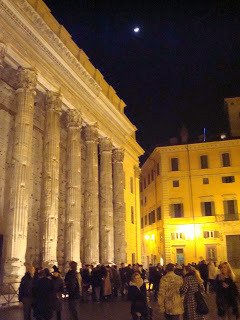
Majestic! And here's the entrance, hidden among the ancient columns:
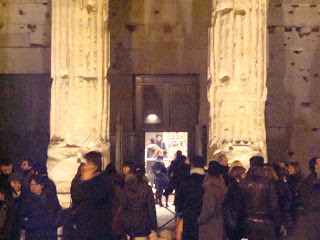
Once in, we were met by a noisy and colorful crowd, with a big video screen at one end of the vast hall:
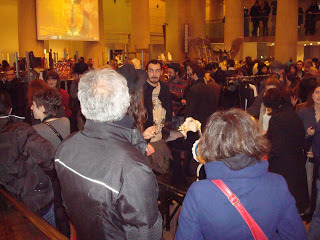
Lots of stands manned by young people, all showing the most eclectic and inventive array of design and fashion products, ranging from weird hats:
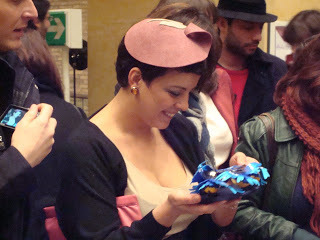
to a variety of rings:

necklaces:
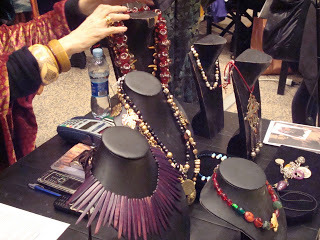
shoes:
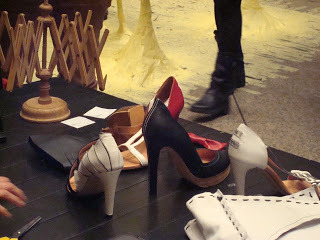
Hummm, a bit heavy, those heels...and when I climbed up to the mezzanine that girds the big hall, I discovered dresses like this:
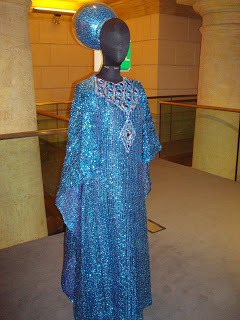
and like this:
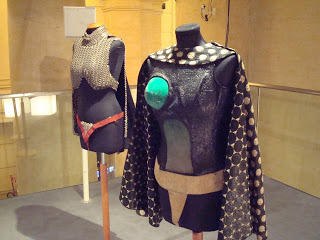
Wondering whether this particular one was meant for a one-breast Amazon, I walked over to the balustrade and took a shot of the hall seen from above:
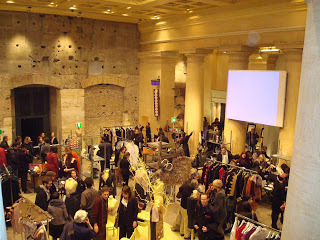
Here you can really appreciate how the "old helps the young": this country has amazing architectural remnants of its long and glorious history that can be used to showcase the work of innovative, young designers. No doubt they're good and inventive, but this kind of environment really helps to set their work off! Old Hadrian called on to support the inventiveness of young Romans...The Temple allure makes the design ideas look elegant and trendy, even if some of them probably aren't.
It's quite a trick to pull off and no doubt one of the elements that help explain the success of Italian design worldwide. Yes, it is one of Italian design's best kept secret: how they are able to exploit the old to the benefit of the new. And of course, how they are inspired by the past to look to the future and invent news ways to do old things.
In one corner of the hall, I came across this surprising stand that confirmed my insight. Here it is:
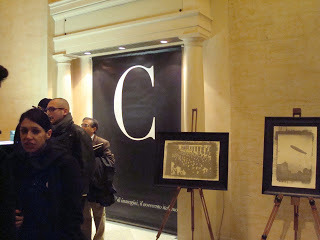
Set between two small columns, a big "C" on a black background stands out - the trademark for Archivio Cicconi, a collection of over 7 million photographs spanning the whole of the 20th century. It is reminiscent of Gucci's double "G" but much starker in its simplicity. Next two it are two of the products one young and inspired artist has ingeniously derived from the old photographs, with a process that was in use at the end of the 19th century.
Here's the artist, Eduardo Cicconi:
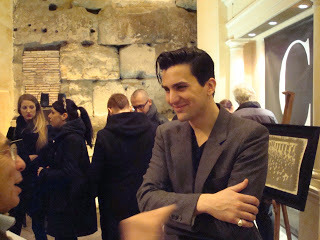
He explained to us that since these photos are reproduced with a handmade process, no two photos are ever alike, thus ensuring that it is an unrepeatable artwork. And they can be made any size, even big enough to cover a whole wall in your living room!
Here is one, derived from a photograph of models in 1948:
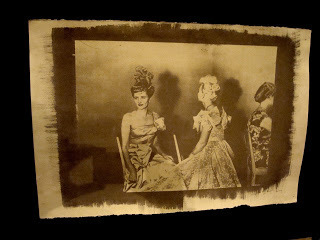
And here's the bizarre zeppelin floating above Piazza Venezia, looking surprisingly ominous:
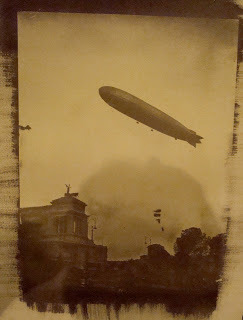
And here's the most extraordinary of the three - a procession of nuns walking through Rome in 1950, like a black pond filled with white balls:
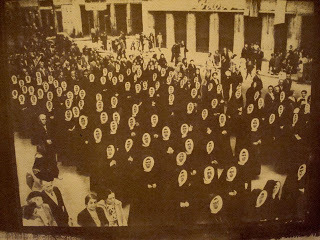
And here's a close up of the material on which the photographs are printed - 100% cotton and you can clearly see the brush work that leaks beyond the edge of the photo:
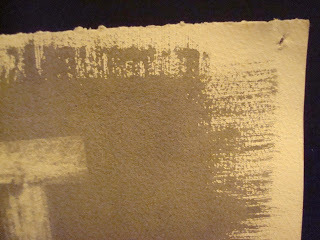
There were also other interesting things on the Cicconi Archives stand, like this old camera:
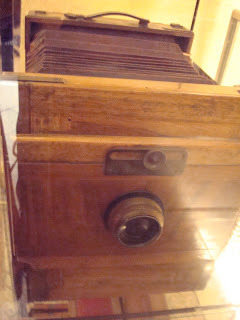
There was also a pile of the latest Cicconi Archives' catalogue (published by the Allori Foundation). Here's the cover:
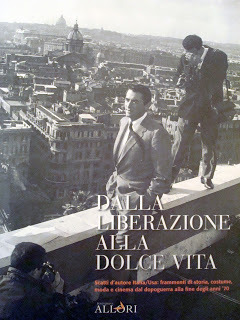
That's Gregory Peck on the roof of the Hassler Hotel in 1959, with St. Peter's in the background. There are lots of photos of famous American actors inside, including my favorite jazz player:
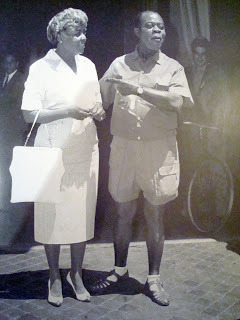
Love his sandals! And here's a very young Ursula Andress (we're in1958) listening to "Pino er Pasticciere" (Pino the pastry cook) - I met Pino years later, in 1985, looking much older but still singing beautifully:
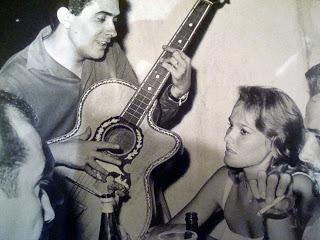
In case you're wondering how this extraordinary collection of photographs was put together, it was the work of Eduardo's father, Alberto Cicconi. By the time he was finished, the Italian Ministry of Cultural and Environmental Heritage recognized it as being of "significant historical interest". For 20 years, Cicconi was
Bettino Craxi's photographer (Craxi is the famous Socialist leader who died in 2000 while in exile in Tunisia). In addition to his own collection (some 645,000 negatives), Cicconi pulled together three other major photo collections all spanning the 20th Century in Italy, including the one put together by Alberto Cartoni who was Mussolini's personal photographer.
I can't resist recounting here the unusual way in which the Cartoni collection was recovered.
One day, Cicconi went to meet Cartoni's grandson with the objective of buying his collection which was said to have few but very important photos. While talking to him, Cicconi became aware that something was oozing out of the wall. He tapped on it and it sounded hollow. They pulled down the wall and were met with a strong smell of must, film and photographs: this was Cartoni's dark room! He had walled it up and hidden his collection in it (which turned out to be quite big: some 460,000 glass negatives and negatives) because, after the war, with the flare-up of hatred for Mussolini, he felt hunted and was afraid his collection would be either taken away from him or destroyed.
It's a good thing that some people in Italy have so much respect for their past...
At 8 pm the fair closed down and we walked the streets around the Temple, looking for a restaurant:
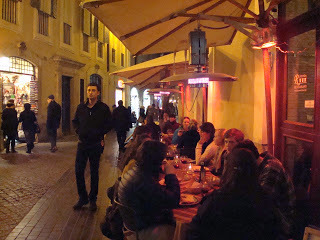
Imagine people eating outdoors in January! It wasn't cold, sure, but I didn't feel like it (too damp). We walked on past the Pantheon:
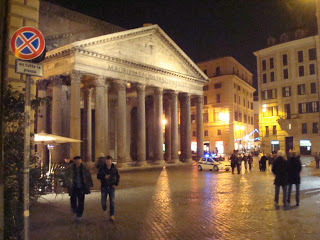
Round the corner, in Via del Seminario, we came to a restaurant my husband remembered from his Dolce Vita days (!):
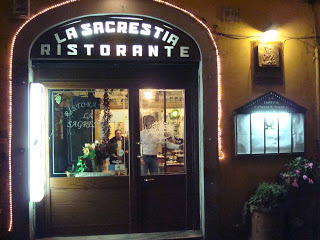
He didn't recognize the owner - small wonder, this restaurant was started in 1946 and now it's the third generation in the family running it:

As you can see, lovingly looking after customers...And the pizza (so my husband says) was just as good as the one he used to eat back in the 1960s:
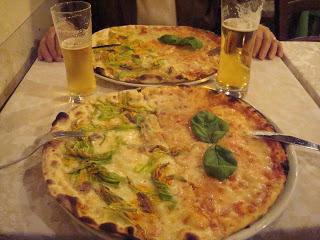
It was certainly delicious, thin and crisp and tasty (on the left, these are zucchini flowers): a fitting end to a wonderful Roman evening stroll!
For more pictures of that memorable stroll, click here:
The A.I. Fair, January 29, 2012



 newest »
newest »
 newest »
newest »
 Despite the Amazon dress and the 12" heels, I loved the Italian fashion tour you provided. My 3-week visit to Italy last year was a glorious experience. Your blog post took me back to that trip . Thank you.
Despite the Amazon dress and the 12" heels, I loved the Italian fashion tour you provided. My 3-week visit to Italy last year was a glorious experience. Your blog post took me back to that trip . Thank you.
 Joseph wrote: "Despite the Amazon dress and the 12" heels, I loved the Italian fashion tour you provided. My 3-week visit to Italy last year was a glorious experience. Your blog post took me back to that trip . ..."
Joseph wrote: "Despite the Amazon dress and the 12" heels, I loved the Italian fashion tour you provided. My 3-week visit to Italy last year was a glorious experience. Your blog post took me back to that trip . ..."





























